This article presents an important topic in the field of restorative dental medicine: the direct restoration of hard dental tissue loss in the frontal area of the dental arches. This can be achieved with great success nowadays, even though the volume of loss of dental hard substance is important. Modern techniques and materials allow for longevity and long-term stability of the restoration, and the physiognomic aspect is fully reproduced, with reduced costs for the patient. The modern composite resins, with which direct restorations are carried out in this area, have both increased biological and adhesion properties, but at the same time they offer a faithful reproduction of the enamel and dentine, from an aesthetic point of view. This is the main requirement of the patients in the modern society, in which the pleasant aspect is a condition of social integration.
Restaurarea directă în zona frontală a distrucţiilor dentare coronare – prezentare de caz
Direct anterior restoration of hard dental tissue loss – case report
First published: 13 decembrie 2019
Editorial Group: MEDICHUB MEDIA
DOI: 10.26416/Orl.45.4.2019.2732
Abstract
Rezumat
Acest articol prezintă o temă de actualitate în domeniul medicinei dentare restaurative: restaurarea directă a distrucţiilor dentare coronare în zona frontală a arcadelor dentare. Aceasta se poate realiza la ora actuală cu mare succes, chiar dacă volumul pierderii de substanţă dură dentară este mare. Tehnicile şi materialale moderne permit o longevitate şi stabilitate pe termen lung a restaurării, iar aspectul fizionomic este redat în totalitate, cu costuri reduse pentru pacient. Răşinile compozite moderne, cu care se realizează restaurările directe în zona anterioară, prezintă atât proprietăţi biologice şi de adeziune crescute, dar oferă în acelaşi timp reproducerea fidelă a smalţului şi a dentinei, din punct de vedere estetic. Aceasta este cerinţa principală a pacienţilor în societatea modernă, în care aspectul plăcut este o condiţie a integrării sociale.
Introduction
In this era, dental medicine is centered to the same extent both on prophylaxis and on dental restoration. Unfortunately, most of it is still represented by the need for restorations of loss of the hard dental substance, which has various causes.
The restorations of hard dental tissue loss, especially the extensive ones, can be realized both by direct and indirect prosthetic methods, all these being available alternatives for the dentist(1). The financial gain may influence the clinician in choosing more elaborate but also more expensive treatment methods, applying for example crowns instead of the direct restorations carried out in the dental office, in situations where less extensive restorations would have been adequate. On the other hand, the new methods and technologies have created confusion regarding the limits of the indications of intra-, extracoronal and partial restorations (inlays, onlays) or full crowns.
It is true that the restoration of the teeth with a certain degree of destruction can be done both by direct and indirect techniques, but this choice must be a correct one, based on scientific arguments. The evolution of both procedures in recent years has been marked by an unprecedented diversification of dental materials, which has attracted new techniques(2,3). The choice of a particular type of material and design of the restoration depends on several factors:
-
the degree of coronal destruction (volume of hard dental tissues loss);
-
the physiognomic aspect required by the patient;
-
the level of oral hygiene, respectively the control of the bacterial plaque (this represents an essential aspect regarding the direct restorations with resin composite materials);
-
the possibilities of achieving a suitable adhesion (for the direct methods) or the optimal retention (for the prosthetic restorations);
-
the financial aspect – the direct restorations in the dental medicine practice have always a lower cost than the ones made in the dental technique laboratory(4).
This article presents the direct method of dental restoration using resin composite materials. Without question, this is certainly the most common technique of hard tissues loss restoration nowadays, irrespective of the etiology. This makes the evolution of restorative materials an explosive one. They have chemical, physical and biological properties more and more closer to the dental tissues they replace: enamel and dentine. Modern composite resins have both proper biological and adhesion properties, which are the main objectives from the point of view of the dental producers and also dentists. At the same time, they offer a faithful reproduction of the enamel and dentine, from an aesthetic regard(5). In the modern society, this is the main requirement we receive from the patients, because pleasant aspect is a condition for social integration and acceptance. Thus, dentists are forced to meet the increasing demands of patients.
The success or failure of the restorations using resin composites largely depends on the clinician’s ability to understand the limitations of these materials and how to use them. The most important aspect is the optimal choice of technique and material in the respective clinical situation(6).
Coronal destruction involves the loss in different degrees of hard dental substance from different etiologies. Depending on the volume of the missing tissues, this can affect the functions of the dento-maxillary system, respectively the masticatory function, the phonation, and the aesthetic aspect of the patient. The etiology of these destructions is represented by dental caries and different types of dental trauma. Also, iatrogenic maneuvers are responsible.
It is well known that, of all the etiological factors of dental hard tissue loss, dental caries have the highest prevalence.
Initially, the dental caries were considered as a chronic disease with irreversible evolution, but at present it is defined as an infectious, dynamic process, carried out at the interface between the tooth and the bacterial plaque.
The presence of dental caries in the front teeth, in the incisal, vestibular or lingual areas is a sign of high and intense carioactivity. These caries lesions that appear on smooth surfaces are mostly extended on the coronal surface. Once dentine is penetrated, the evolution is rapid, extending laterally and towards dental pulp. The clinical aspect reveals the disruption of the enamel surface, with an opaque area visible through translumination and radiotransparency(7). As all other dental caries, the loss of hard dental tissue in incisors and canines affects the functions of the dento-maxillary system, especially the physiognomic function, so the restorative treatment is a must.
Case report
A male patient (43 years old) presented to the dental practice for restoration of massive loss of hard dental tissues in tooth 21. The etiology was dental caries, associated with a bad habit to keep a pencil into the mouth. The tooth had already root canal treatment, but the patient postponed the coronal restoration, so the carious lesion continued to develop (Figure 1).
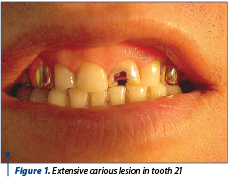
The restorative method we chose for this clinical case was armed direct resin composites restoration. The glass fiber post allows a better and long-lasting stability and retention of the composites restoration(8).
The treatment steps were as follows: removing the dental plaque with professional brushing, and choosing the proper color tooth shade. The affected dental tissues were removed completely, both enamel and dentin. Then, a root canal preparation was made, for a proper insertion of glass fiber post (Figure 2).
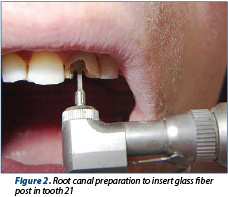
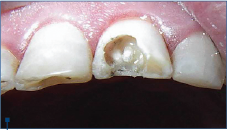
The post was cemented into the root canal with dual-cured resin-composite cement (Figure 3). The glass fiber post offers good retention and also a proper physiognomic appearance. It is almost invisible inside the coronal resin composites restoration.
After the post had been fixed into the prepared root canal, the next stage of treatment consisted in restoring the coronal tissue loss. We followed the specific dental adhesion steps using total-etch technique, dentin and enamel adhesion and insertion of resin composites. The reconstruction of the tooth started with the lingual surface in order to achieve a good aesthetic result. The resin composite was inserted using incremental technique, namely stratified layering technique. This was done by applying the composite resin restorative materials that include different shades of dentin and enamel (Figure 4 and Figure 5).
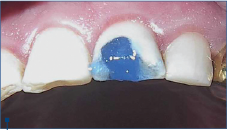
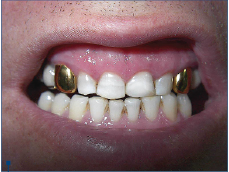
The direct anterior restoration of hard dental tissue loss, even when the coronal destruction is extensive, should be the first choice in most of the clinical cases we are confronted with(9,10). If the restorative method is correct and the technique is rigorously followed, the results are spectacular in just one single visit, while assuring a long-term stability and with low costs for the patient.
Acknowledgements: All the authors have equal contributions for this article.
Conflict of interests: The authors declare no conflict of intersts.
Bibliografie
- Staehle HJ, Wolff D, Frese C. More conservative dentistry: clinical long-term results of direct composite resin restorations. Quintessence Int. 2015 May; 46(5):373-80.
- Eltahlah D, Lynch CD, Chadwick BL, Blum IR, Wilson NHF. An update on the reasons for placement and replacement of direct restorations. J Dent. 2018 May; 72:1-7.
- Weston JF. Predictable nanohybrid composite systems and techniques for anterior and posterior direct restorations. Compend Contin Educ Dent. 2013 Jul-Aug; 34 Spec No 5:8-12.
- Iliescu A, Gafar M. Cariologie şi odontoterapie restauratoare. Editura Medicală. 2013; Bucureşti.
- Paolone G. Direct composites in anteriors: a matter of substrate. Int J Esthet Dent. 2017;12(4):468-481.
- Brown KM, Gillespie G. Advancements in Composite Resin Material Enable Streamlined Direct Restoration Process. Compend Contin Educ Dent. 2019 Nov/Dec; 40(suppl 2):2-6.
- Popa MB. Estetică în odontoterapia restauratoare. Ed. Univ. „Carol Davila”, Bucureşti, 2006.
- Migliau G, Piccoli L, Di Carlo S, Pompa G, Besharat LK, Dolci M. Comparison between three glass fiber post cementation techniques. Ann Stomatol (Roma). 2017 Jan-Mar; 8(1): 29–33.
- Congiusta MA. No differences in longevity of direct and indirect composite restorations. Evid Based Dent. 2017 Jun 23; 18(2):46.
- Schlichting LH, Stanley K, Magne M, Magne P. The non-vital discolored central incisor dilemma. Int J Esthet Dent. 2015 Winter; 10(4):548-62.
Articole din ediţiile anterioare
Sensibilitatea postoperatorie asociată restaurărilor cu răşini compozite
În practica clinică ne confruntăm adesea cu durerea postoperatorie dentinară care apare după restaurarea directă coronară cu răşini compozite. Ar...
Esthetic function direct restoration in the anterior area – case report
Restaurarea cu succes a funcţiei fizionomice a zonei anterioare a arcadelor dentare impune ca medicul dentist să aibă cunoştinţe avansate despre ...
Modalităţile actuale de tratament pentru leziunile dentare eroziv-abrazive
Erosive and abrasive dental lesions are commonly encountered in dental practice due to the multifactorial etiology involved, with several mechanism...
Tratamentul leziunilor dentare necarioase
Leziunile dentare necarioase – fie că sunt cu sau fără pierdere de substanţă – conduc la apariţia tulburărilor fizionomice, având, de asemenea, un ...